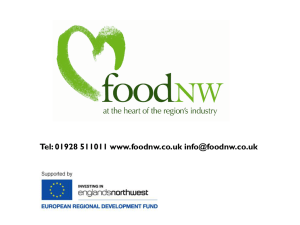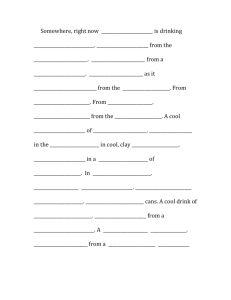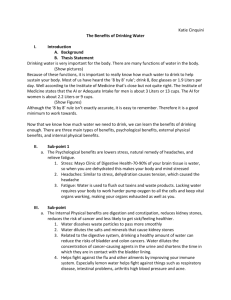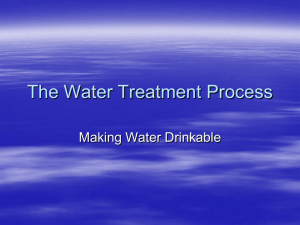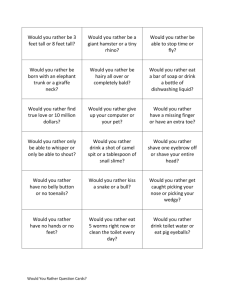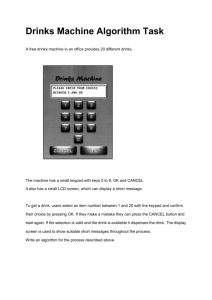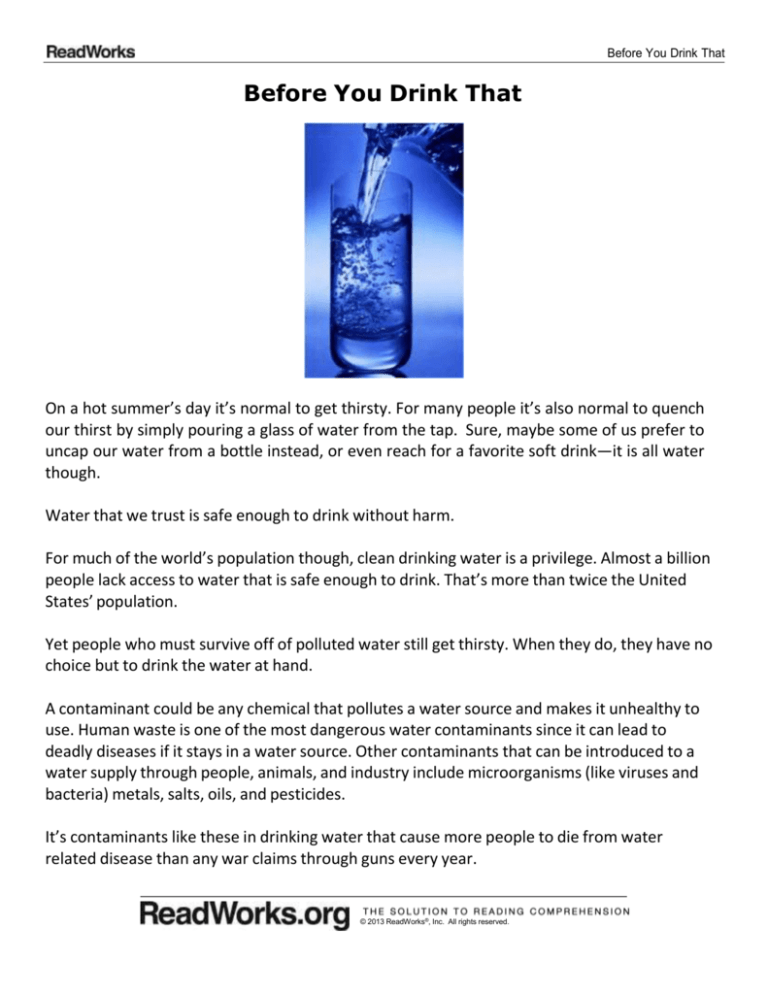
Before You Drink That
Before You Drink That
On a hot summer’s day it’s normal to get thirsty. For many people it’s also normal to quench
our thirst by simply pouring a glass of water from the tap. Sure, maybe some of us prefer to
uncap our water from a bottle instead, or even reach for a favorite soft drink—it is all water
though.
Water that we trust is safe enough to drink without harm.
For much of the world’s population though, clean drinking water is a privilege. Almost a billion
people lack access to water that is safe enough to drink. That’s more than twice the United
States’ population.
Yet people who must survive off of polluted water still get thirsty. When they do, they have no
choice but to drink the water at hand.
A contaminant could be any chemical that pollutes a water source and makes it unhealthy to
use. Human waste is one of the most dangerous water contaminants since it can lead to
deadly diseases if it stays in a water source. Other contaminants that can be introduced to a
water supply through people, animals, and industry include microorganisms (like viruses and
bacteria) metals, salts, oils, and pesticides.
It’s contaminants like these in drinking water that cause more people to die from water
related disease than any war claims through guns every year.
© 2013 ReadWorks®, Inc. All rights reserved.
Before You Drink That
Water quality cannot be measured by any single factor. So every community must determine
its own health goals for its water supply.
There are many ways water may be judged too dangerous for drinking.
A community in Brazil may decide on different standards than one in Australia. In the United
States the Environmental Protection Agency (EPA) protects our water supplies from pollution,
and establishes the scientific standards for water safety.
The main points to consider are if the water is affordable, safe, and reliable. This means
knowing the quality of the water from its source all the way through to when it ends up in
your glass.
Protecting against the potential for contamination must be addressed both on a day‐to‐day
basis and through long term planning. Making sure water is healthy and easy to access means
ensuring its safety over a person’s entire lifetime.
One major challenge in many developing communities is collecting water from distant sources.
After they fill up their 40‐pound jars with water, many people who live in villages far away
from clean drinking supplies have to carry their water many miles to their homes.
They may even have to make multiple trips in a single day to bring enough water for their
families. Traveling back and forth from their water source every day can require many hours,
and take them away from the things they love to do.
Imagine if in order to survive you no longer had time to go to school or meet with friends
because you needed to spend most of your day fetching water.
In the country of Bangladesh, arsenic, a very poisonous chemical, was discovered in many of
the wells. Arsenic can cause cancer and skin illnesses in humans if regularly drunk.
The deadly poison cannot be removed easily, and contaminates the water drunk in the very
crowded urban areas, where people move to find work. As more people live in extremely close
quarters, trying to survive on as little as one dollar a day, overcrowding, poor housing, and
unhealthy trash dumping all contribute to the water crisis.
© 2013 ReadWorks®, Inc. All rights reserved.
Before You Drink That
There are many other problems for communities trying to consistently provide their citizens
with the highest possible quality of drinking water.
After a large storm in New York City in the early summer of 2012, flooding overwhelmed a few
of the local water treatment plants. They became backed‐up, pouring thousands of tons of
sewage into nearby water channels.
Luckily the waste didn’t enter the water supply.
It could the next time though.
The plants’ breakdown shows how even in highly developed cities with top‐notch technology
the water supply can become unpredictably endangered or unreliable.
The World Health Organization recommends that even once the most harmful contaminants
are removed, improvements of taste, smell and appearance should continue to be a constant
goal. Keeping the water supply healthy is a never‐ending mission.
Since all people depend on water to survive, making healthy drinking water available to
everyone is a matter that governments and scientists are urgently working to solve. So far
they’re trying experiments that range from simple to complex, cheap to expensive, and large
to small.
Some non‐governmental organizations are working with local communities anywhere on the
planet to raise money and build new water supply systems.
They don’t just come and dig new wells either. Instead they work with locals to understand
their needs, help create loans to pay for the new water system, and teach them how to
successfully use it.
Meanwhile researchers at Pennsylvania State University are working with seeds from the
Moringa tree, a tree that grows near the earth’s equator, to “scrub” water clean.
The tree’s seeds contain proteins that can be used to attract and kill contaminants. Until
recently this method, while good at cleaning water, was costly and used complicated
technology.
© 2013 ReadWorks®, Inc. All rights reserved.
Before You Drink That
However, the team at Pennsylvania State has created a way of rinsing the seeds with sand that
may provide a simpler and less expensive way to make drinking water.
At Rice University in Texas more researchers in search of low‐cost ways to remove arsenic
from water are testing sand that is coated in graphite. Graphite is the same metal that is used
in pencils.
Both the sand and graphite are abundant so easy for rural villages to find and use to clean
their water.
Using sand to purify, or clean, water is an old approach, but the combination of both sand and
graphite makes for a new material that “is several times more efficient at removing
contaminants than sand alone,” according to Rice University.
The university’s tests have shown results that restored even heavily polluted water to safe
levels.
One possible flaw in the so‐called “super sand” may be that the graphite would eventually
melt back into the water and release the poisons it had absorbed.
Then there’s the Japanese company that lets riders turn their favorite bicycles into water
purifying stations. They’ve found a way that bikes can be outfitted with containers, which once
filled, run water sources through a series of cleaning filters when the cyclist peddles.
By adding the ability for users to transport their clean water, the water purifying bicycles could
be extremely useful in remote villages and disaster zones.
One purification method that is popping up in many varieties is the solar still. Solar means
powered by the sun.
Solar stills are often used in emergencies when water suddenly becomes scarce. They use a clear
sheet of glass or plastic to heat up moisture from the ground until it evaporates, or turns to water
vapor. Then the evaporated water is allowed to drip into a container such as a bowl or a cup.
They can be made very simply and cheaply, or on large enough scales to water large
greenhouses.
© 2013 ReadWorks®, Inc. All rights reserved.
Before You Drink That
In the future solar stills could be used to turn deserts into suitable farmlands.
Another way to get clean water is from rain.
Due to air pollution rainwater still needs to be cleaned, but inventors are coming up with all
kinds of designs to get the job done.
A man from Vancouver, Canada built a portable rain collector and purification backpack from
supplies he bought from Home Depot.
An Iranian student built a bus stop that purifies rainwater and is powered by sunlight.
All of these different designs offer important options for people who may be suffering from
lack of clean water for many different reasons. Since there is no one cause of contaminated
water, it’s important for individuals and communities to be able to choose the solution that
best suits their needs.
We’re going to need all of these ideas to solve the problem of providing clean water for the
entire world.
The bottom line is that clean water is essential to human life, and a healthy supply must be
available to all. Improving access to safe drinking water results in many health benefits that
everyone has a right to enjoy.
No matter where you live it should be safe to reach for a cool glass of water on a hot summer’s
day.
© 2013 ReadWorks®, Inc. All rights reserved.
Questions: Before You Drink That
Name:
Date:
1. What is a contaminant?
A
B
C
D
any chemical that pollutes a water source and makes it unhealthy to use
any chemical that purifies water and makes it safe to drink
organizations that work to increase access to clean water around the world
water treatment plants that have become backed-up and release sewage into
nearby water channels
2. Almost a billion people lack access to water that is safe enough to drink. Which
solution is discussed in the passage as one way to address this problem?
A
B
C
D
building more water treatment plants in remote areas
moving populations of people to clean freshwater sources
pouring thousands of tons of sewage into nearby water channels
using sand and graphite to remove contaminants in water
3. New technologies and innovations may help solve the global water problem. Which
evidence from the passage supports this statement?
A Many people have to carry water many miles to their homes.
B A water treatment plant broke down in New York City after a large storm in the
summer of 2012.
C Graphite may melt back into the water and release the poisons it has absorbed
if it is used to remove contaminants from water.
D Solar stills can be used on large scales to collect water from the ground.
4. What can be inferred about the distribution of the world’s clean water?
A
B
C
D
Clean water is generally less accessible in developing communities.
Clean water is only accessible in highly developed cities.
Clean water is only accessible in wealthy nations with strong governments.
Access to clean water is only a problem in very few countries across the world.
1
© 2013 ReadWorks®, Inc. All rights reserved.
Questions: Before You Drink That
5. What is the main idea of the passage?
A Lack of access to clean water causes millions of deaths every year.
B Lack of clean water is a major issue worldwide, and many groups are making
efforts to solve the problem.
C Communities must work on their own, without national or worldwide support, to
improve their access to water.
D Many innovative ideas, some created by everyday citizens, have improved
worldwide access to clean water.
6. Read the sentences: “Yet people who must survive off of polluted water still get
thirsty. When they do, they have no choice but to drink the water at hand.”
What does the word “polluted” most nearly mean?
A
B
C
D
clean
contaminated
cold
thick
7. Choose the answer that best completes the sentence below.
A community in Brazil may decide on different water standards than one in Australia.
, there are many ways water may be judged too dangerous for drinking.
A
B
C
D
Before
Thus
However
Because
8. Arsenic was discovered in many of the wells in Bangladesh. What is arsenic and how
can it impact someone’s health?
2
© 2013 ReadWorks®, Inc. All rights reserved.
Questions: Before You Drink That
9. How do some non-governmental organizations work with local communities to improve
access to water?
10. Explain which technological design or plan meant to improve access to water would
most effectively address the issue of arsenic in the wells in Bangladesh. Use information
from
the
passage
to
support
your
answer.
3
© 2013 ReadWorks®, Inc. All rights reserved.
Teacher Guide & Answers: Before You Drink That
4
© 2013 ReadWorks®, Inc. All rights reserved.



